Quick Reference
1927
Sugaring season: Feb. - Apr.
Herbert Keach Farm
Avery Road, Buckland, MA
Oil on Canvas
Landscape
Sugaring
Originally 40 x 50
cut down to 24 x 36.
National Academy of Design, 1927
Springfield Art league, 1927,★ '37
> Award: Best Landscape
Pennslvania Academy FA, 1928
Art Institute of Chicago, 1928
Myles Standish Galleries, '29, '31
Smith Coll. Tryon Gallery, 1931
Mt. Holyoke Coll. Dwight Hall, 1931
Williston Academy, 1931
International Rotary Convention
Boston, MA, 1933
Myles Standish Hotel, Boston, 1944
"Best Landscape"
Springfield Art league, 1928
NA- The painting remains in the
estate of the artist.
An RSW favorite, it remanded in his
personal collection.
Related Links
- See also the...
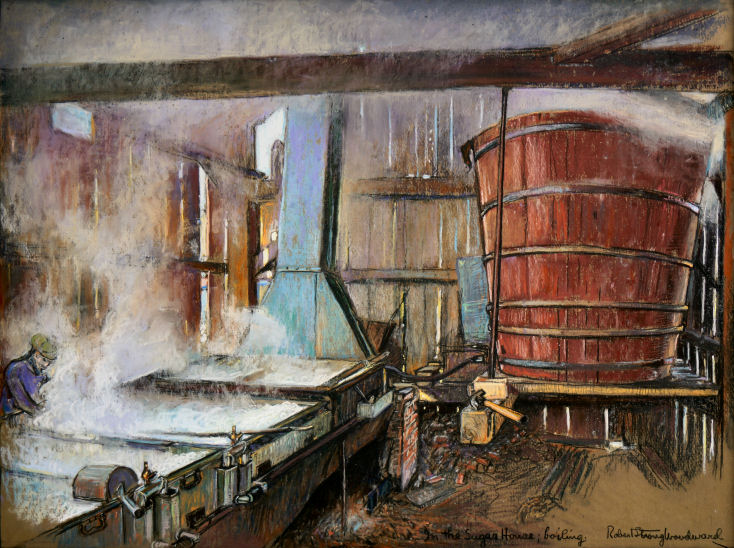 Sugaring Gallery to view related pieces.
Sugaring Gallery to view related pieces.
- See also the...
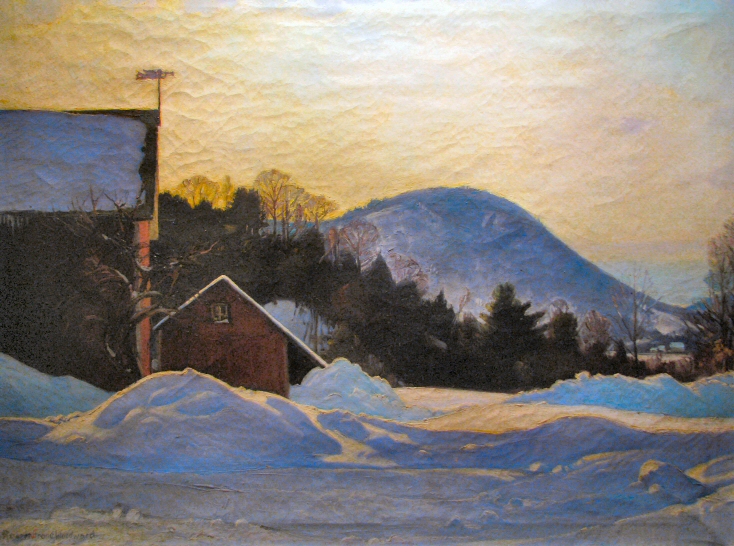 Snow on the Ground Gallery to view related pieces.
Snow on the Ground Gallery to view related pieces.
- See also the...
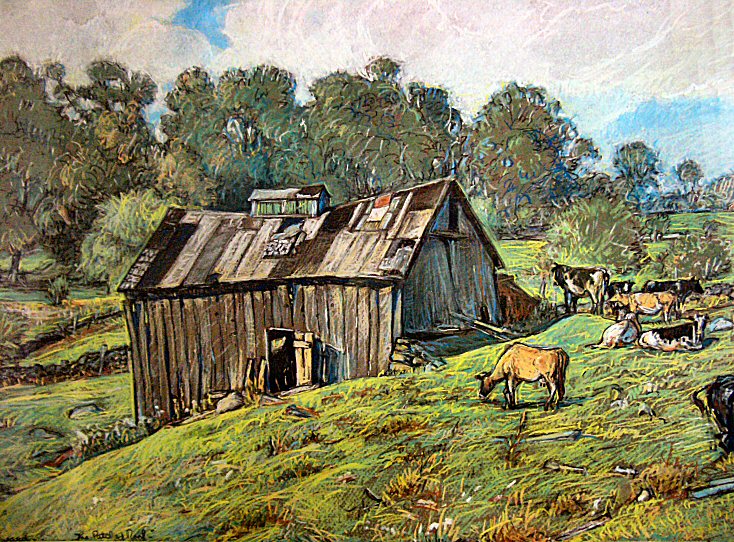 People & Livestock Gallery for related pieces.
People & Livestock Gallery for related pieces.
- See also the...
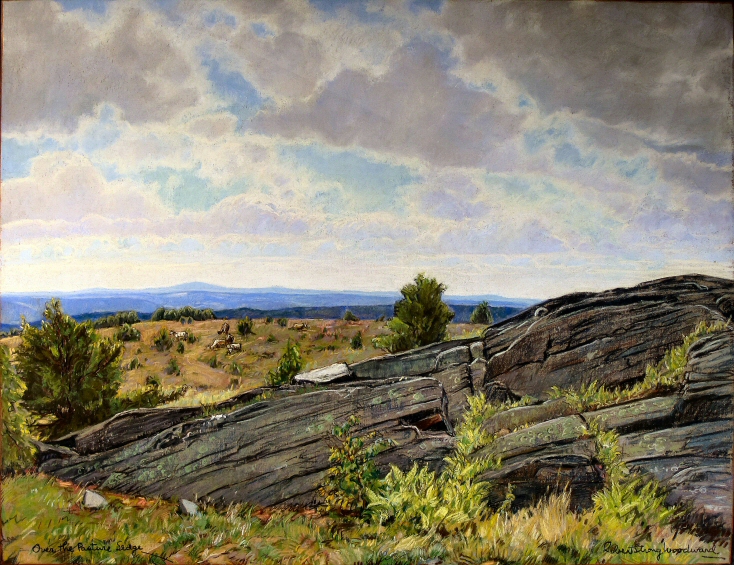 Rocks & Stone Walls Gallery to view related pieces.
Rocks & Stone Walls Gallery to view related pieces.
- See our page devoted to ...
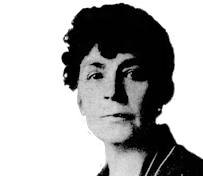 RSW patron Mrs. Everett
RSW patron Mrs. Everett
- See our page devoted to ...
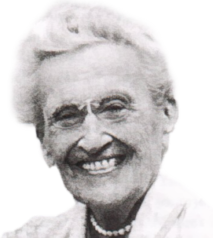 RSW sponser, patron-saint Ada Small Moore
RSW sponser, patron-saint Ada Small Moore
- See our page devoted to ...
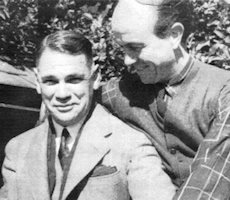 RSW friend and Hollywood Interior Designer Harold Grieve
RSW friend and Hollywood Interior Designer Harold Grieve
- See our page devoted to ...
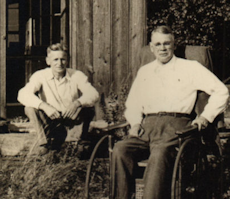 RSW friend, educator, and amateur photographer F. Earl Williams
RSW friend, educator, and amateur photographer F. Earl Williams
- See also the...
 Sugaring Gallery to view related pieces.
Sugaring Gallery to view related pieces.
- See also the...
 Snow on the Ground Gallery to view related pieces.
Snow on the Ground Gallery to view related pieces.
- See also the...
 People & Livestock Gallery for related pieces.
People & Livestock Gallery for related pieces.
- See also the...
 Rocks & Stone Walls Gallery to view related pieces.
Rocks & Stone Walls Gallery to view related pieces.
- See also the...
180.png) Award Winners Gallery to view related pieces.
Award Winners Gallery to view related pieces.
- See also the...
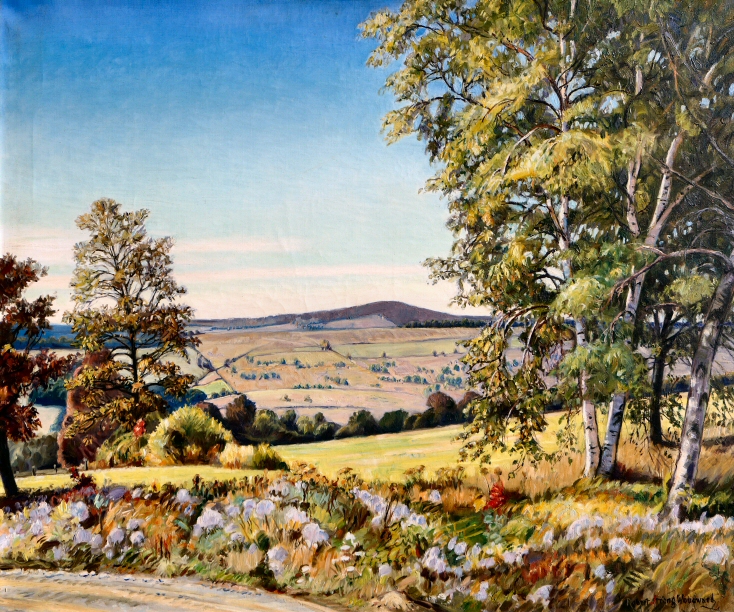 Landscapes & Views Gallery to view related pieces.
Landscapes & Views Gallery to view related pieces.
Featured Artwork: When Drifts Melt Fast 
734.png)
The image above is of the full version of this painting taken from a newspaper clipping with what remains of it today.
Click here for a high resolution image of painting
RSW's Diary Comments
"Painted prior to 1930. A large sugaring picture, hemlock and maple woods, a steep straggly hillside in the foreground, a team of horses drawing a red gathering tub down a rutted wood road in the upper middle distance. Red sap buckets, of course, scattered among the trees, lingering snow drifts here and there. Shown at the National Academy in N. Y. in...then at the Annual Exhibition of the Springfield Art League ( Mass.) where it was awarded in...This canvas hung several seasons in Miss Alice Brown's Sweetheart Tea House. A very impressive canvas, but never sold (1947)"
Comments on the back of a sepia print:
 "Painted in H. L. Keach's sugar orchard in Buckland. The drawing
of the trees is remarkable."
"Painted in H. L. Keach's sugar orchard in Buckland. The drawing
of the trees is remarkable."
 "Awarded First Landscape Prize in 1927, Springfield Art League Exhibition, Springfield, Mass."..
"Awarded First Landscape Prize in 1927, Springfield Art League Exhibition, Springfield, Mass."..
Editor's Note:
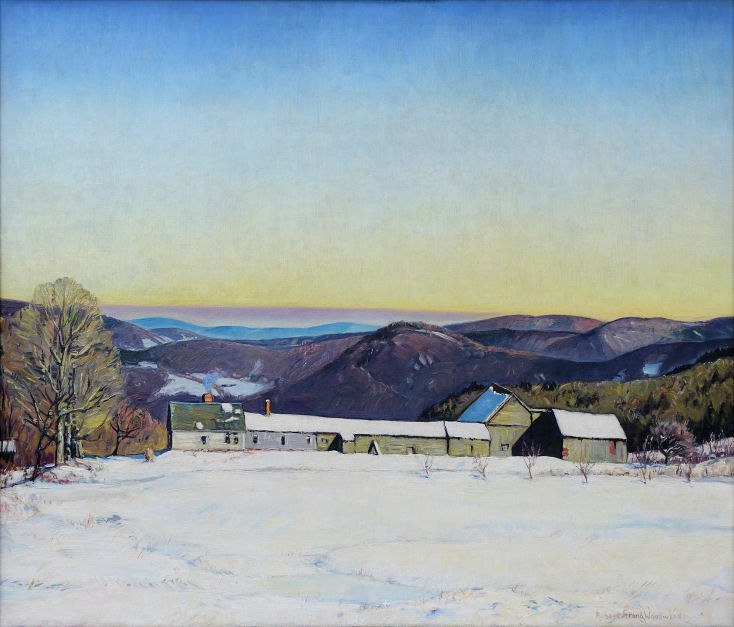
 Courage and Peace, 1933
Courage and Peace, 1933
This painting is a personal painting to RSW. It is
both strong to his brand of radiance but yet edit-
orial in its depiction of that which is distinctly New
England. He made another smaller version for his
dear friend in California, Harold Grieve named,
Peace and Courage, while Courage and Peace was
sent to the famed Macbeth galleries in New York City
in 1935 for his patron-saint and sponsor, Mrs. Ada
Small Moore to purchase. Mrs. Moore is perhaps the
ONLY person who could have pried it from Wood-
ward's hands aside from the Whitney Musuem or
the MET or better yet, the Art Institute of Chicago in
Illinois or the Museum of Fine Arts in Boston, Mass.
We need to get something straight here and it might rub some people the wrong way because it runs contrary to
Woodward's actual testimony in his Painting Dairy. But we no longer buy the idea that ALL of these "personal favorite" paintings "never sold."
Of the 11 paintings he claimed were his "favorites" or "best", 9 remain in his personal collection and so we are calling a foul on the artist for
being misleading. We are calling nonsense. This is clear cut New England Stoicism obfuscating (understatement) the matter in over-
simplification.
It is true the painting never sold but Woodward is not giving us the context of WHY these paintings did not sell.
Our records show that all of his most personal paintings, the one's we call his "editorial" or "brand" paintings either went to museums or were
sold to his best customers (of which four of them are famed art collectors); or someone famous ( like
Robert Frost ); or to personal friends such as F. Earl Williams
or Harold Grieve; for which we are also sure he did not give them
a discount either. ( He was well known to be a stickler on price. ) So what Woodward is really saying is that the right buyer never presented
themselves for him to part with the painting. He would be much more honest to say, 'I love it so much I never found the RIGHT
home for the painting to let it go.' [Read the caption to the right]
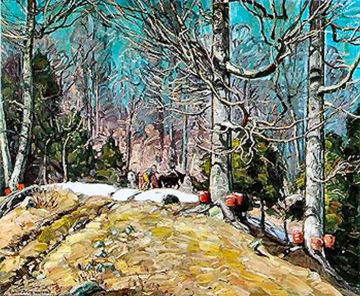
Gathering Sap, from the 1996 auction
 Case in point: From this painting, Woodward made two smaller versions. One,
Gathering Sap, went to a great patron of the arts and someone he knew since he was
a kid living in Ohio and later California, Mrs. Josephine Everett of
Cleveland, OH, and Pasadena, CA. She would later donate it to the Pasadena Museum of Art. The other,
Sap Gathering was sold to a Holyoke businessman who Woodward just happen to still be in touch with 20 years later when
he was compiling his Painting Diary and listed the family's new home and address in Montclair, NJ, suggesting there was a personal
nature to their relationship than just artist and buyer.
Case in point: From this painting, Woodward made two smaller versions. One,
Gathering Sap, went to a great patron of the arts and someone he knew since he was
a kid living in Ohio and later California, Mrs. Josephine Everett of
Cleveland, OH, and Pasadena, CA. She would later donate it to the Pasadena Museum of Art. The other,
Sap Gathering was sold to a Holyoke businessman who Woodward just happen to still be in touch with 20 years later when
he was compiling his Painting Diary and listed the family's new home and address in Montclair, NJ, suggesting there was a personal
nature to their relationship than just artist and buyer.
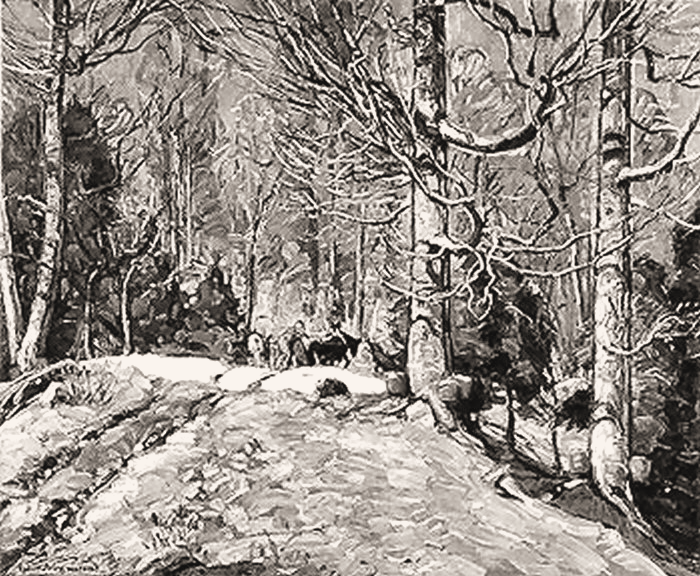
Sap Gathering, Sepia print
Finally consider this, When Drifts Melt Fast ranks up there as one of the most celebrated paintings in Woodward's
entire career. It hung at the National Academy and the Pennsylvania Academy. It is his first painting to hang in the Art Institute of Chicago as
well as part of the first exhibit at the Tyron Gallery of Smith College. All of this while still being blackballed in New York City as a result of his
disastrous Redgate Studio fire 5 to 7 years after it happened
and STILL not yet a member of the Boston Art Club although he had been exhibiting there since 1918!
If you need more evidence,
consider the paintings it hung with at the International Rotary Convention in 1938: the 1930 Gold Medal winning
New England Drama; Enduring New England that is hanging
at Yale University as part of the Mabel P. Garvan Collection, and
Benediction which is of a subject he made two other noted versions of -
Out of New England Soil and Mr. Franklin's House. As a footnote,
New England Drama remained in the estate of the artist. Mr. Franklin's House was sold to close friends,
the Rosenzweigs and Out of New England Soil was sold to friend F. Earl Williams and later presented to his alma mater, the
Deerfield Academy where it hangs in the Boyden Library Study Room.
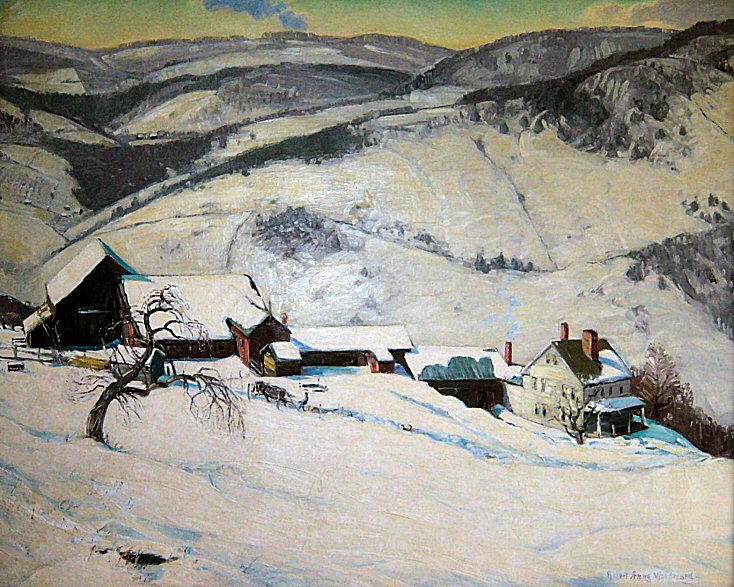
 New England Drama, 1930
New England Drama, 1930
Awarded only one of four Gold Medal Prizes at the
Tercentennial Birthday celebration for Boston in 1930.
Two prizes went to portraits, another a scuplture.
This painting also holds the rare distinction of exhib-
iting at 2 of the Myles Standish Gallery events, as well
hanging in the hotel dining room for several years.
Further evidence of just how meaningful this painting was to the artist. It is the ONLY one of just a handful of personal favorites to have
hung at all 3 of his biggest Myles Standish Gallery exhibitions: the premier exhibit in 1929; the most highly reviewed exhibit in 1931; and the
big finale of the hotel's existence before it shuts its doors in 1944.
For it to also hang "several seasons" in one of the most iconic
attractions of Shellburne on the Mohawk Trail, the Sweetheart Tea house and its thousands of yearly visitors and events. We know of no other
painting to have hung there. As a matter of emphasis, both New England Drama and Enduring New England hold the
rare distinction of exhibiting at all 3 major Myles Standish Gallery/Hotel events.
This painting has quite a resume, perhaps unequaled,
even without New York's Macbeth and Grand Central Galleries or the Boston Art Club to add to it. And you will see below that the prize it won in
the 1927 Springfield Art League show was not up against a minor league stable of local artist but some really big names.
Additional Notes
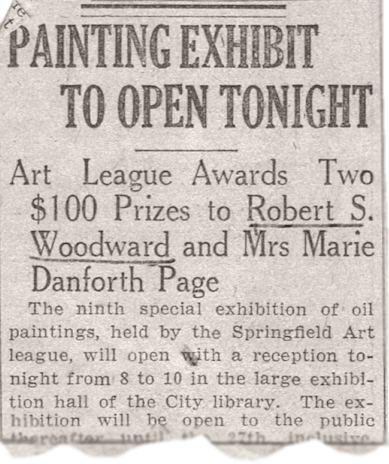
 Springfield Union, November 12, 1927
Springfield Union, November 12, 1927
Right: The Springfield Union, November 12, 1927
"The league's two prizes of $100 each, for the best landscape or marine and the best figure or portrait have been awarded to Robert S. Woodward for his landscape, 'When Drifts Melt Fast,' and to Mrs Marie Danforth rage for her group, 'Polly in Pink. Honorable mention is awarded Anthony Thieme for his landscape, 'Quarry...'"
 Note: Anthony Thieme is a well known Rockport artist and a major figure of the Rockport
(MA) School of American regional art. He was also an art teacher opening his own school, the Thieme School of Art, and also taught at the Grand Central
Art Gallery's school of art on the top floor of the Grand Central Station in New York City. There is also evidence that Thieme and Woodward became
friends, possibly through Stanley Woodward. We have a picture of what looks like the "Quarry" hanging
in Woodward's living room sometime in the late 1930s.
Note: Anthony Thieme is a well known Rockport artist and a major figure of the Rockport
(MA) School of American regional art. He was also an art teacher opening his own school, the Thieme School of Art, and also taught at the Grand Central
Art Gallery's school of art on the top floor of the Grand Central Station in New York City. There is also evidence that Thieme and Woodward became
friends, possibly through Stanley Woodward. We have a picture of what looks like the "Quarry" hanging
in Woodward's living room sometime in the late 1930s.
Other Notable Artist from the Exhibit:
 Harriet R Lumis
Harriet R Lumis
 W. Lester Stevens, and
W. Lester Stevens, and
 Wayman Adams
Wayman Adams
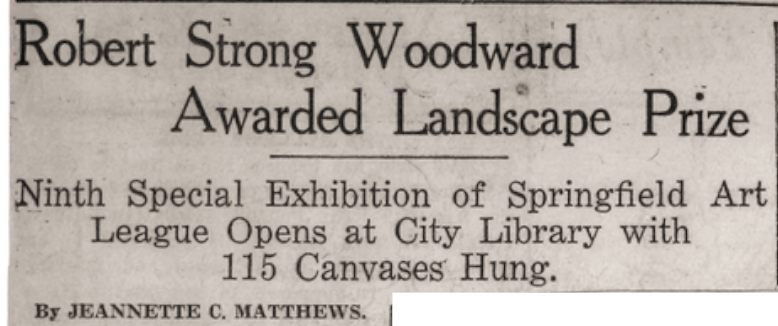
 Jeanette Matthews review, Springfield Union
Jeanette Matthews review, Springfield Union
November 12, 1927
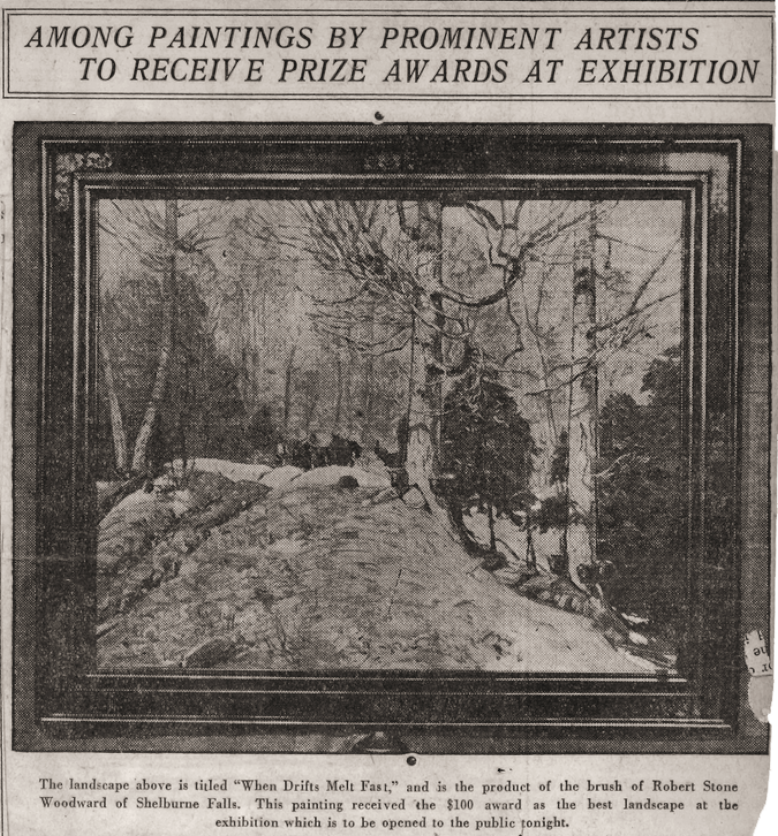
 Springfield Union, November 12, 1927
Springfield Union, November 12, 1927
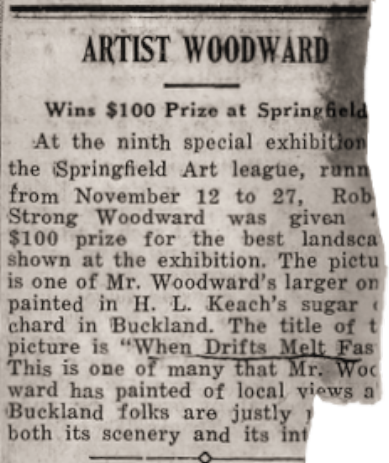
 Gazzette Courier, Dec. 18, 1927
Gazzette Courier, Dec. 18, 1927
An excerpt of Matthews remarks on Woodward:
"Here is a New England scene distilled to its poetical essence in color and light, a thawing muddy wood road, snow filled to the ruts, the bare maple trees each flaunting a scarlet sap bucket and yonder in the distance the plodding team and rough wagon with the driver who has been collecting the sap. The creation of still, sparkling cold with no medium but paint, is achievement enough. One detailed comment I cannot forbear, the drawing of the trees is remarkable. With full light upon the bare trunks and leaden sky behind them they have been almost outlined in black and the further emphasis this gives the light upon them as well as the way it makes them live is surprising. Mr. Woodward seems to have identified himself in spirit with his trees."
CLICK HERE TO READ THE ENTIRE
JEANETTE MATTHEWS REVIEW
Excerpt from B. K. , June 23, 1928 | Re: Pennsylvania Academy of Fine Art Exhibit:
".....perhaps the most splendid of the entire lot is, however, done on a sunless day---a gloriously brilliant hillside, presumably in Vermont, of which one remembers best bluest sky and bright red buckets on the sugar maples. This is Robert Strong Woodward's When Drifts Melt Fast. It won a prize from the Springfield Art League and it is easy to see why....."
Excerpt from A. J. Philpott, Boston Globe, May, 1929 | Re: Myles Standish Gallery Show:
"It is no wonder that the big picture, When Drifts Melt Fast, took first prize at the Springfield Art League Show a few years ago. For that is a notable picture, not only in the virile manner in which it is painted, but in the whole character of the composition...."
Excerpt from Flora White, Heath, June 3, 1931 | In a letter to the editor of the North Adams Transcript following the Smith College Exhibit:
"A brilliant work, full of the vitality and rhythm of spring surgings, red buckets on gray trunks, horses in the distance dragging their load of gathered sap - sunshine, promise, flickering through the leafless branches - but the inner meaning of the scene is conveyed in the deep irregular ruts of the foreground which the load has left in its trail."
Bonus Material: The Painting's Demise and Restoration
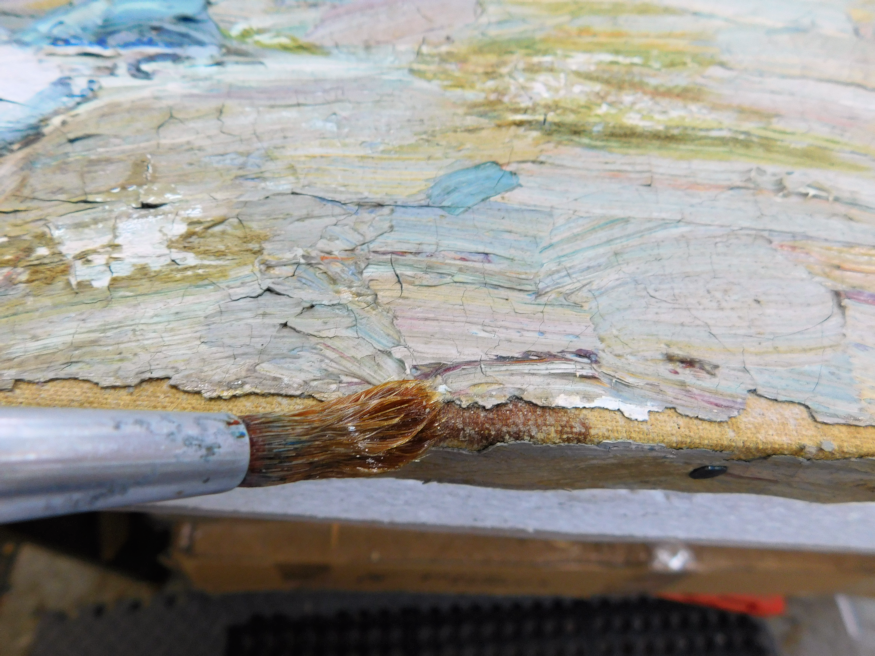
 The years of decay left the painting brittle and
The years of decay left the painting brittle and
flaking off as this picture taken courtesy of Bruce Wood
of the Woodshed Gallery in Franklin, MA.
The history of this painting's deterioration is actually not well documented, however, it is fairly well-known to us. We simply
misunderstood the facts until we assembled them. What we know comes from an oral history given by
Dr. Mark, the websites founder.
Dr. Mark told us years ago the painting was once an upright. At the time, Dr. Mark was
the reigning authority on Woodward, because he worked for the Artist for nearly 14 years and crew to become like a son to him. After his
death Woodward left the bulk of his estate to the aspiring doctor and his wife, Barbara, shortly after their nuptials in 1950.
What we were told was that Woodward had first cut the painting down because it was chipping and years later after his death, Dr. Mark,
followed the lead of the Artist and cut it down a second time for the same reason. The painting was not holding up to time. Something
was wrong.
Our misunderstanding of these facts was the presumption that the painting started out as as an upright. 50" x 40"
perspective. This was long before we began to compile and sort and process all of Woodward scrapbook into some sort of collection.
The articles in the scrapbook held two newspaper images of the original painting in 1927 showing that it was in fact a landscape view.
This determined the rest...
Below are the various stages of this painting's life span going left to right in a Z order:
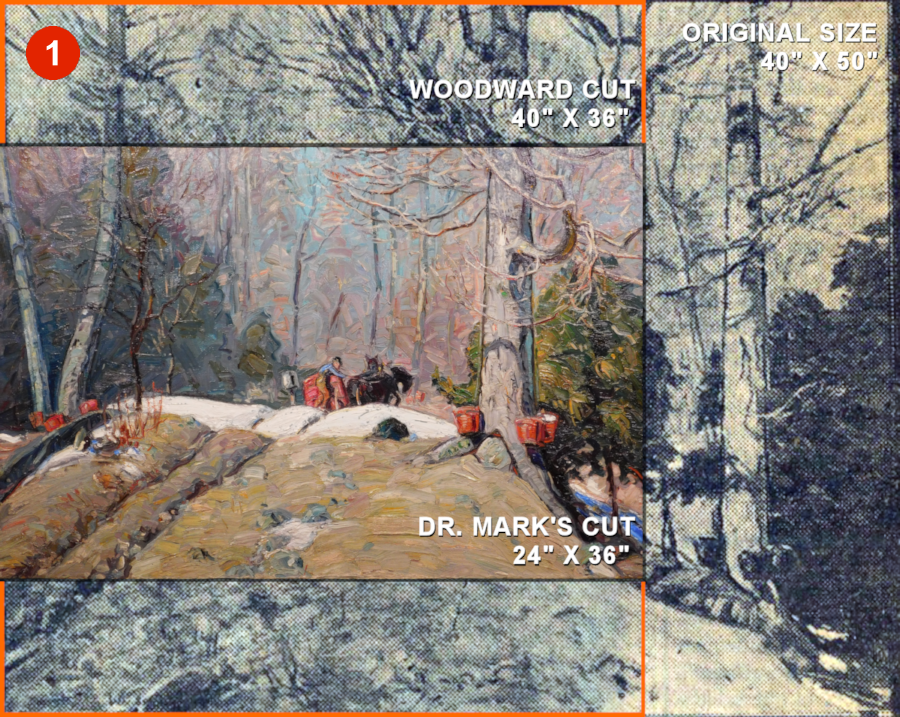
 This is the full painting showing how we be-
This is the full painting showing how we be-
lieve the cuts occurred. Woodward's cut had to be
14 inches of the entire right side of the painting.
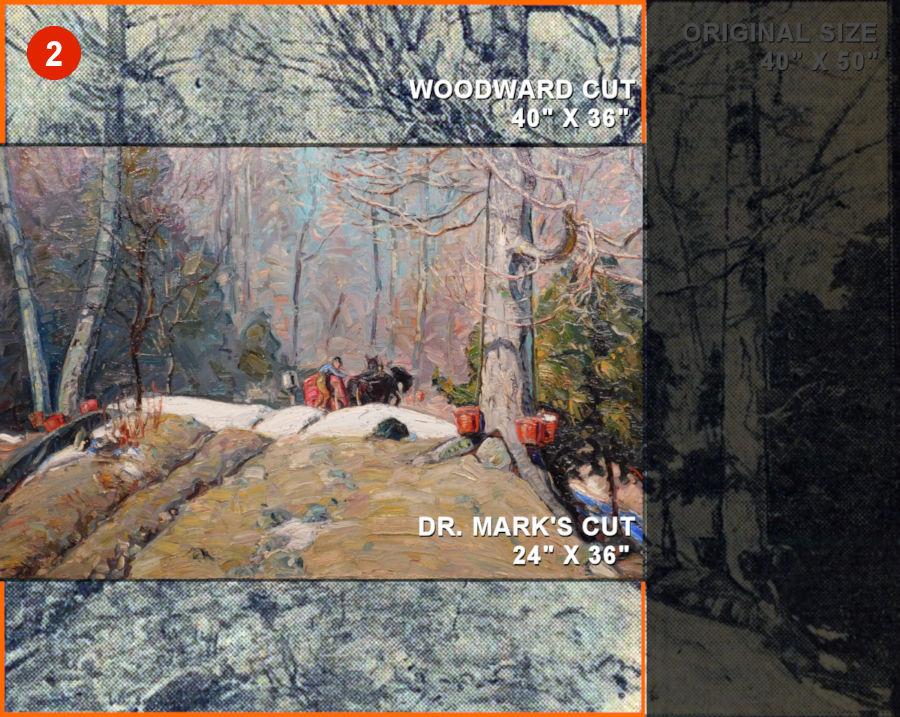
 The new size of the painting is now H 40"
The new size of the painting is now H 40"
x W 36" upright painting as Dr. Mark said it was.
Dr. Mark then cut it further to its current size.
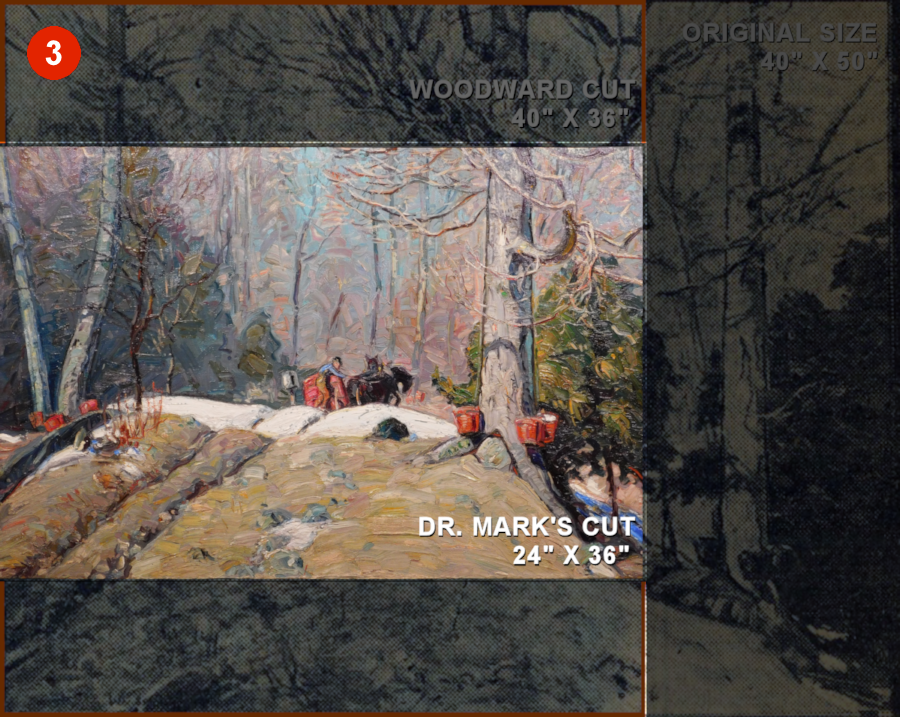
 We believe, because we can't ask him to confirm
We believe, because we can't ask him to confirm
it, that Dr. Mark chose a common size to fit an avail-
able frame, except it could have easily cut to 25" x 30".
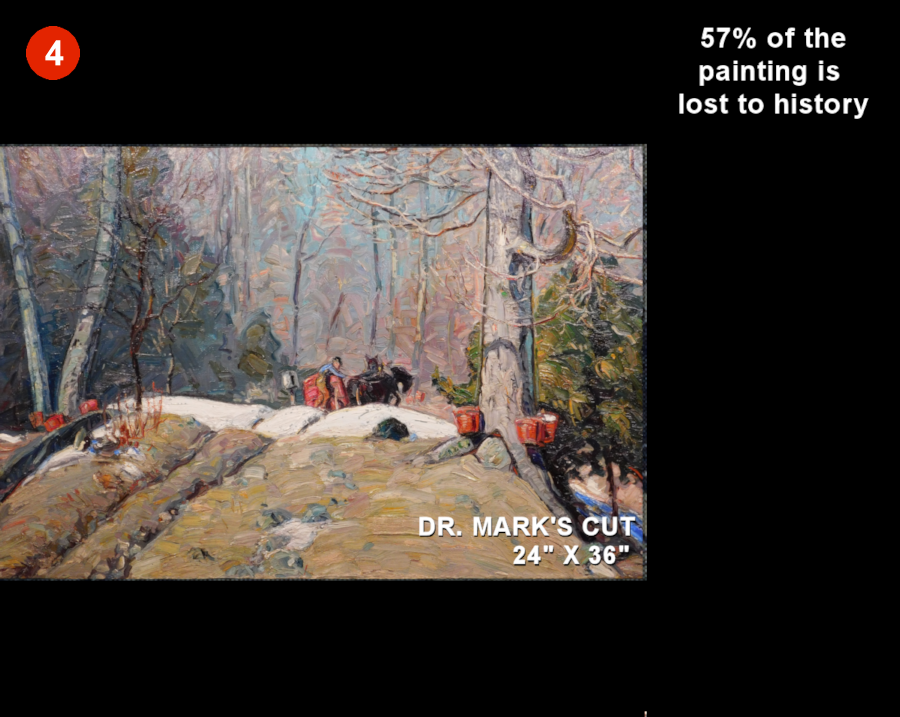
 Perhaps Dr. Mark wanted to save as much of it as
Perhaps Dr. Mark wanted to save as much of it as
he could. Its current size is 114 sq. in. MORE than the 25
x 30 size and 54sq. in. than 27 x 30 (both as common).
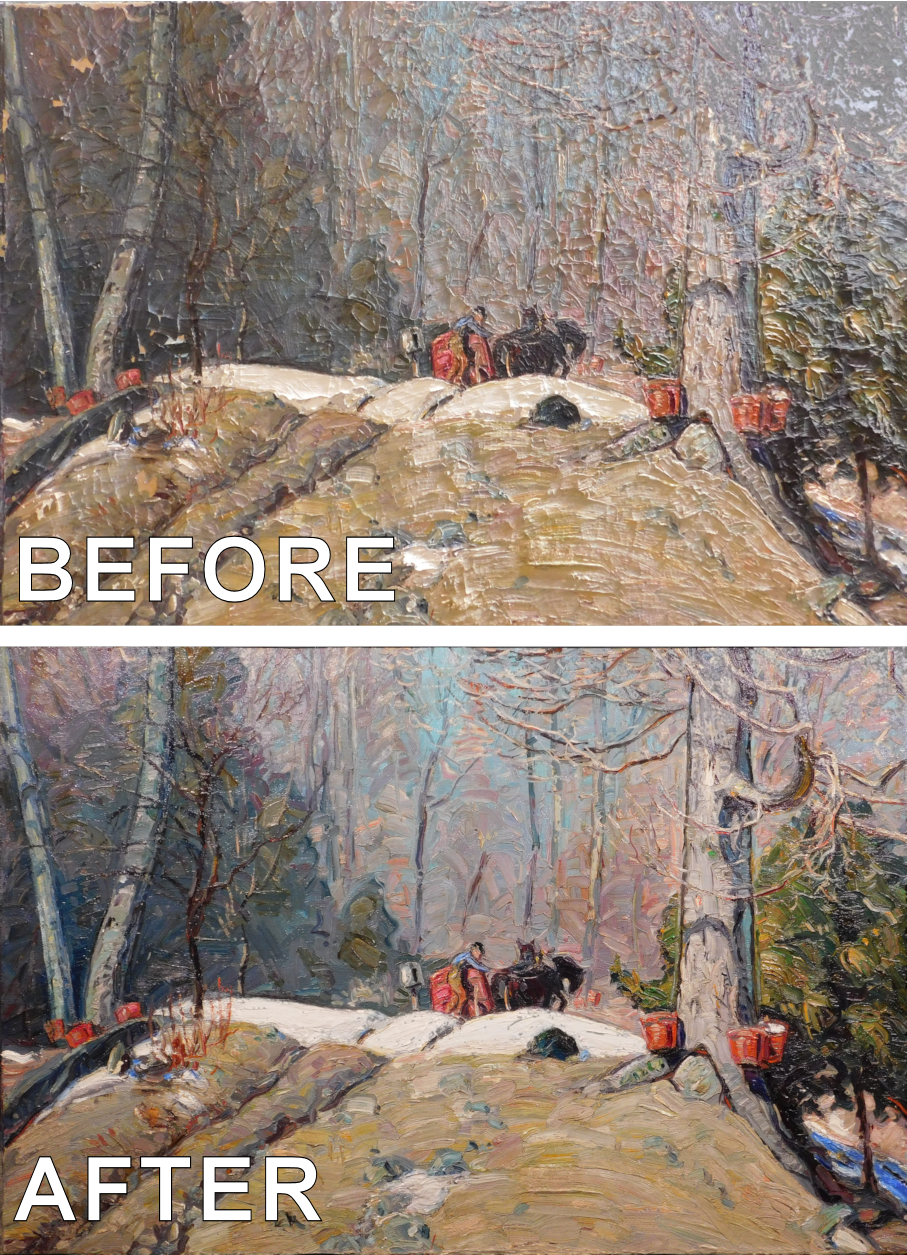
 CAPTION FOR PIC
CAPTION FOR PIC
So here is what we believe were the stages of the painting's alterations. The artist cut it down to the 40" x 50" to
what we believe was a 40" x 36" canvas. Later, as the painting continued to crumble, Dr. Mark cut it again, and stretched it to its
current size of H24" x W36 inches.
We do not know what year Dr. Mark made his cut. Larch was too young to remember
if he ever saw it as an upright. What we do know is that its last years at the Southwick Place it hung in Dr. Mark's old waiting
room for several years. When the Southwick place was sold in 2021 and we had to pack up everything. When we took the painting
off the wall, several pieces of it fell off.


